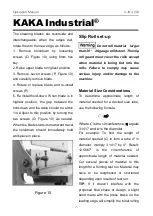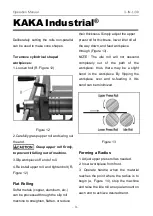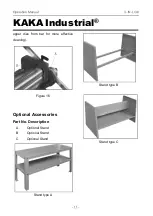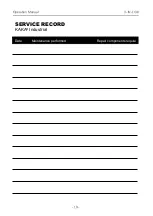
Operation Manual
3-IN-1/30
KAKA Industrial
®
- 5 -
allowance based upon thickness of
material. This can be done either through
trial and error, or by consulting a
machinist’s handbook.)
9. Rest workpiece on v-block (lower die)
so that the scribed line is aligned with the
tips of upper die(s).
10. Hold workpiece steady and use
operating handle to make bend.
To adjust brake beam (G, Figure 6) for
90
°
bends at bottom of stroke:
1. Slightly loosen locking screws (H)
using 8mm hex key.
2. Turn brake beam adjusting screws (G)
with 19mm wrench, until test bends
reflect 90° bend at both ends of brake.
3. Re-tighten screws (H).
Figure 6
For special repetitive bends, the brake
beam may be adjusted to over-bend the
desired angle since the metal will have
some degree of “spring back”.
Shear set-up
Do not shear material
larger than 30
”
20 gauge mild steel.
Failure to comply may cause serious
injury and/or damage to the machine.
1. Install guide rods and plate in shear
position (Figure 4) and adjust to desired
length of workpiece cut.
2. Place workpiece against guide block at
right edge of table (K, Figure 7). The end
of workpiece should be against guide
plate.
3. Operate handle to begin shearing cut.
Shearing action progresses from right to
left.
NOTE: 1. To prevent distortion when
notching,
“
snap
”
the handle to facilitate
piercing.
2. Do not reach behind the machine to
catch the cut-off piece. A large cut-off
piece should be allowed to drop onto a
special table designed to catch pieces
that are bigger than the workbench.
3. Large pieces being cut may require a
front table to support the piece.






































